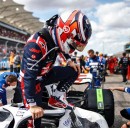You may have noticed that whenever the Formula 1 cars are in the garage, their tires are covered with blankets. They serve to get the tires up to a working temperature, so when the drivers hit the track, they will spend as little time as possible getting them to optimal conditions.
FIA plans to phase them out by 2024, and this decision put them, yet again, under attack from both the drivers and experts. This season, the temperature has already been decreased, from 100 degrees Celsius up front and 80 in the rear to 70 all around, with a further 20 degrees decrease planned for 2023.
This was evaluated at the last test in Austin during the practice session along with the 2023 Pirelli tires. The Mexican GP was also supposed to have a 50 degrees Celsius tire test, but that seems to have been scrapped.
Even so, the Austin GP showed more than enough about the reduction in temperature for the tire blankets. The current world champion Max Verstappen told the media that he almost crashed in the pit lane during that practice session due to the tires not being heated to the optimum temperature. The Red Bull driver also said that he thought there would be a lot more crashes with the rule changes.
He went on to say, “Your tire degradation is going to be completely different because your tires are very cold, you’re sliding around a lot in the first few laps, your tire pressures are going to go through the roof, so your tires are going to dig a lot more. At the moment I don’t really enjoy it, but a lot of drivers say the same and we have to of course find a solution to that. Austin is still a track where you can easily switch on the tires because of the high-speed corners. But if you go to a track like a street circuit, like Monaco, can you imagine half-and-half conditions, I think it’s going to take like half the race before you have temperature in your tires.”
McLaren driver Lando Norris has echoed Max’s concerns with an emphasis on safety. The Brit remarked, “This was like the best possible conditions to have these tires: super-warm, hot track temp, high-speed first sector to get the temp in. And they were not nice. So easy to front lock, so easy to rear lock, completely unpredictable. Imagine going to a much colder race track, or if it’s a little bit damp or something. Everyone’s going to shunt the car at some point. No driver wants it, basically.”
He also went on about how the current Formula 1 car design was not compatible with this goal, saying that, “To drive a current era Formula 1 car, which is designed so specifically with all the aero and stuff, in a way not made to go out on cold tyres, it’s not like a Formula 2 or Formula 3 car where you can just throw it about and do whatever.”
He also points out that there have already been discussions between the drivers and the stakeholders, with the most vocal arguments coming from drivers that have experienced the lighter cars and better tires from the previous generations of cars.
More experienced drivers like Valtteri Bottas and Kevin Magnussen are also opposed to the idea. They both think it simply cannot work with either the current tires or the ones Pirelli plans to introduce in 2023. Magnussen has gone further and said that he thinks the decision comes from a lack of understanding, with the people pushing for it not having driven a Formula 1 car.
All Formula 1 drivers seem to be worried about the safety of their cars. It is something that has evolved immensely throughout the years. The teams and the FIA have worked hard to make this possible, with the introduction of features like the halo and robust materials. Why then would they insist on banning the tire warmers when they appear to be crucial to how the tires perform on track?
This was evaluated at the last test in Austin during the practice session along with the 2023 Pirelli tires. The Mexican GP was also supposed to have a 50 degrees Celsius tire test, but that seems to have been scrapped.
Even so, the Austin GP showed more than enough about the reduction in temperature for the tire blankets. The current world champion Max Verstappen told the media that he almost crashed in the pit lane during that practice session due to the tires not being heated to the optimum temperature. The Red Bull driver also said that he thought there would be a lot more crashes with the rule changes.
He went on to say, “Your tire degradation is going to be completely different because your tires are very cold, you’re sliding around a lot in the first few laps, your tire pressures are going to go through the roof, so your tires are going to dig a lot more. At the moment I don’t really enjoy it, but a lot of drivers say the same and we have to of course find a solution to that. Austin is still a track where you can easily switch on the tires because of the high-speed corners. But if you go to a track like a street circuit, like Monaco, can you imagine half-and-half conditions, I think it’s going to take like half the race before you have temperature in your tires.”
McLaren driver Lando Norris has echoed Max’s concerns with an emphasis on safety. The Brit remarked, “This was like the best possible conditions to have these tires: super-warm, hot track temp, high-speed first sector to get the temp in. And they were not nice. So easy to front lock, so easy to rear lock, completely unpredictable. Imagine going to a much colder race track, or if it’s a little bit damp or something. Everyone’s going to shunt the car at some point. No driver wants it, basically.”
He also went on about how the current Formula 1 car design was not compatible with this goal, saying that, “To drive a current era Formula 1 car, which is designed so specifically with all the aero and stuff, in a way not made to go out on cold tyres, it’s not like a Formula 2 or Formula 3 car where you can just throw it about and do whatever.”
He also points out that there have already been discussions between the drivers and the stakeholders, with the most vocal arguments coming from drivers that have experienced the lighter cars and better tires from the previous generations of cars.
More experienced drivers like Valtteri Bottas and Kevin Magnussen are also opposed to the idea. They both think it simply cannot work with either the current tires or the ones Pirelli plans to introduce in 2023. Magnussen has gone further and said that he thinks the decision comes from a lack of understanding, with the people pushing for it not having driven a Formula 1 car.
All Formula 1 drivers seem to be worried about the safety of their cars. It is something that has evolved immensely throughout the years. The teams and the FIA have worked hard to make this possible, with the introduction of features like the halo and robust materials. Why then would they insist on banning the tire warmers when they appear to be crucial to how the tires perform on track?















